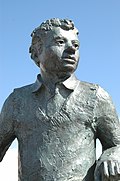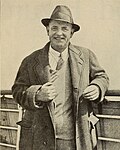| Image | Name | Born | Died | Age at death | Details of funeral / memorial | Occupation |
|---|
 | Robert Adam | 1729 | 1792 | 63 | Grave & gravestone | Architect |
 | Isaac Barrow | 1630 | 1677 | 46 | Grave & marble memorial bust on a pedestal by John Bushnell [10] | Mathematician |
 | Francis Beaumont | 1584 | 1616 | 31–32 | Grave is unmarked. Name is inscribed on the Abraham Cowley gravestone. [11] | Playwright |
| ... | John Beaumont | 1583 | 1627 | 43–44 | Unmarked grave [11] | Poet |
| ... | William Benson | unknown | 1549 | unknown | Grave & memorial stone [12] | Abbot of Westminster |
 | Mary Eleanor Bowes | 1749 | 1800 | 51 | Grave & gravestone. Reported by some to have been buried in a court dress, with all the accessories necessary for a Royal audience, plus a small silver trumpet, and by others as in her bridal dress. [13] | Poet and playwright |
 | Robert Browning | 1812 | 1889 | 77 | Browning's grave & gravestone is immediately adjacent to that of Alfred, Lord Tennyson [14] | Poet and playwright |
 | Richard Busby | 1606 | 1695 | 88–89 | Busby is buried beneath the pavement of the Choir while his memorial, by the sculptor Francis Bird, is located in the South Transept. [15] | Headmaster |
 | William Camden | 1551 | 1623 | 72 | Marble memorial bust with surround [16] | Antiquarian and historian |
 | Thomas Campbell | 1777 | 1844 | 66 | Funeral 3 July 1844.; [17] Statue by William Calder Marshall erected 1848 [18] | Poet |
 | Henry Francis Cary | 1772 | 1844 | 72 | Funeral 14 August 1844. [19] Grave & gravestone in Poets' Corner [20] | Author and translator |
 | Isaac Casaubon | 1559 | 1614 | 55 | Wall monument in black & white marble by sculptor Nicholas Stone [21] | Classical scholar |
 | William Chambers | 1723 | 1796 | 75 | Grave & gravestone in South Transept [22] | Architect |
 | Geoffrey Chaucer | c. 1343 | 1400 | 56–57 | Actual grave site is now unmarked but his name is inscribed on the Cowley gravestone. A grey Purbeck marble memorial was erected in 1556. [23] | Author and poet |
 | Abraham Cowley | 1618 | 1667 | 48–49 | White marble monument, of an urn on a pedestal, by John Bushnell [24] Large black marble gravestone to which several further names have been added. | Poet |
 | Richard Cumberland | 1732 | 1811 | 79 | Grave & gravestone in South Transept [25] | Playwright |
 | William Davenant | 1606 | 1668 | 62 | Grave & gravestone in South Transept [26] | Poet and playwright |
 | John Denham | 1614 or 1615 | 1669 | 63–65 | Grave is unmarked. Name is inscribed on the Abraham Cowley gravestone. [27] | Poet |
 | Charles Dickens | 1812 | 1870 | 58 | Dickens's will did not dictate his place of burial, but stipulated that there be no grand funeral ceremony. He was therefore given a secret early-morning funeral in the Abbey, 14 June 1870. [28] | Author |
 | Michael Drayton | 1563 | 1631 | 67–68 | Died in London. Memorial bust & surround in alabaster & black marble placed by the Countess of Dorset, with lines attributed to Ben Jonson. [29] | Poet |
 | John Dryden | 1631 | 1700 | 68 | Grave is unmarked. Name is inscribed on the Cowley gravestone. Memorial bust on pedestal by Peter Scheemakers was erected in 1731, replacing an earlier memorial. [30] | Poet and playwright |
| ... | Adam Fox | 1888 | 1977 | 93–94 | Grave & gravestone in South Transept [31] | Oxford Professor of Poetry
Canon of Westminster Abbey |
 | David Garrick | 1717 | 1779 | 61 | Grave plus monument in white and grey marble by Henry Webber on the west wall of Poets' Corner [32] | Actor |
 | John Gay | 1685 | 1732 | 47 | Buried in South Transept, with a monument by John Michael Rysbrack which is now in the Queen's Diamond Jubilee Galleries [33] | Poet and playwright |
 | William Gifford | 1756 | 1826 | 70 | Gifford wanted to be buried in South Audley Chapel, "but for the pressing request of his grateful executor [ John Ireland, Dean of Westminster ], who was anxious that Gifford's remains should be mingled with the great and good in Poets' Corner, Westminster-abbey." [34] | Poet and editor |
 | George Grote | 1794 | 1871 | 76 | Marble bust by Charles Bacon, 1873 [35] | Historian |
 | Richard Hakluyt | c.1552 | 1616 | 63–64 | Unmarked grave thought to be in the South Transept [36] | Author |
 | George Frideric Handel | 1685 | 1759 | 74 | Life-size sculpture by Louis-François Roubiliac with musical scores and instruments represented. [37] [38] | Composer |
 | Thomas Hardy | 1840 | 1928 | 87 | Hardy's funeral, on 16 January 1928, was controversial. Hardy had wanted to be buried at Stinsford in the grave of his first wife, Emma. His executor, Sir Sydney Carlyle Cockerell, was adamant that Hardy warranted interment in the Poets' Corner. A compromise saw his heart buried at Stinsford, and his ashes at the Abbey. | Author and poet |
 | John Henderson | 1747 | 1785 | 38 | Buried at the foot of the grave of David Garrick in the south transept. The inscription has now worn away but it read: "Underneath this stone are interr'd the remains of John Henderson who died the 25th day of November. 1785 aged 38 years". [39] | Actor |
 | Henry Irving | 1838 | 1905 | 67 | Grave & gravestone [40] | Actor |
 | Samuel Johnson | 1709 | 1784 | 75 | Bust by Joseph Nollekens located above Johnson's grave [41] | Author, poet and lexicographer |
 | Rudyard Kipling | 1865 | 1936 | 70 | Grave & gravestone [42] | Author and poet |
| ... | Nicholas Litlyngton | before 1315 | 1386 | 70+ | Grave & memorial stone [43] | Abbot of Westminster |
 | Thomas Macaulay | 1800 | 1859 | 59 | Public funeral, 9 January 1860, with a bust by the sculptor George Burnard erected in 1866. [44] [45] | Poet and historian |
 | James Macpherson | 1736 | 1796 | 59 | Grave & gravestone [46] | Author and poet |
 | John Masefield | 1878 | 1967 | 88 | According to his wishes, was cremated and his ashes placed in Poets' Corner. | Poet and author |
| ... | Robert Moray | 1608/9 | 1673 | 63–65 | Grave is unmarked. Name is inscribed on the Cowley gravestone. | Statesman and natural philosopher |
 | Gilbert Murray | 1866 | 1957 | 91 | Grave & gravestone [47] | Scholar and translator |
 | Laurence, Lord Olivier | 1907 | 1989 | 82 | Grave & memorial stone [48] | Actor |
 | Old Tom Parr | 1483 | 1635 | 152 | Grave & gravestone [49] | Supposedly long-lived Englishman |
 | Matthew Prior | 1664 | 1721 | 57 | Grave is unmarked. Name is inscribed on the Cowley gravestone. Memorial, designed by James Gibbs, with a bust by Antoine Coysevox and figures by John Michael Rysbrack erected by 1726. [50] | Poet and diplomat |
 | Nicholas Rowe | 1674 | 1718 | 44 | Buried in South Transept, with a monument by John Michael Rysbrack which is now in the Queen's Diamond Jubilee Galleries [51] | Playwright and poet |
 | Charles de Saint-Évremond | 1610 | 1703 | 93 | Grave is unmarked. Name is inscribed on the Cowley gravestone. Memorial was also erected. | Essayist and literary critic |
 | Richard Brinsley Sheridan | 1751 | 1816 | 64 | Grave & gravestone [52] | Playwright and poet |
 | Robert South | 1634 | 1716 | 81 | Monument by Francis Bird [53] | Theologian and poet |
 | Edmund Spenser | c. 1552 | 1599 | 46–47 | Marble memorial erected in 1620 on south wall of Poets' Corner, fully restored 1778 [54] | Poet |
| ... | Robert Stapylton | c.1607 | 1669 | 61–62 | Unmarked grave in the South Transept [55] | Playwright |
| ... | Mary Steele | 1678 | 1718 | 40 | Grave and gravestone in South Transept [56] | Letter writer |
 | Alfred, Lord Tennyson | 1809 | 1892 | 83 | Large public funeral, 12 October 1892. [57] In 1893 the government formally requested there be a bust of Tennyson in Poets' Corner. The businessman-botanist Charles Jenner offered Thomas Woolner's 1857 bust of Tennyson to the Abbey, and it was placed near Tennyson's gravestone, by moving a tablet to Christopher Anstey, in 1895. There was no formal unveiling ceremony. [58] | Poet |
 | Connop Thirlwall | 1797 | 1875 | 78 | Marble bust by sculptor Edward Davis [59] | Bishop and historian |
 | Thomas Triplet | 1602 | 1670 | 68 | Marble memorial on west wall of South Transept [60] | Prebendary |
 | Eva Marie Veigel | 1724 | 1822 | 98 | Buried with her husband David Garrick [32] | Dancer |





























































































































































